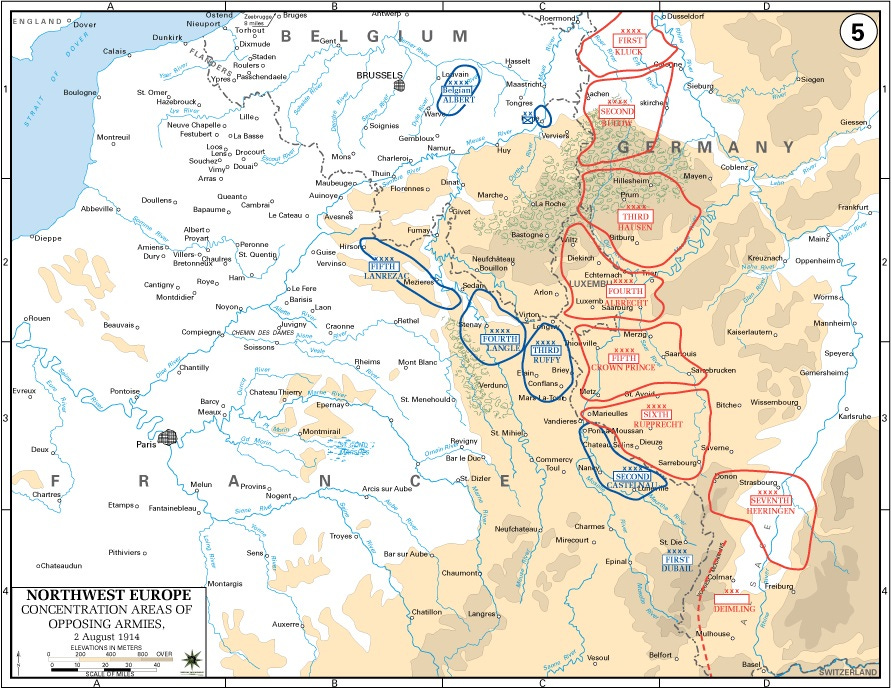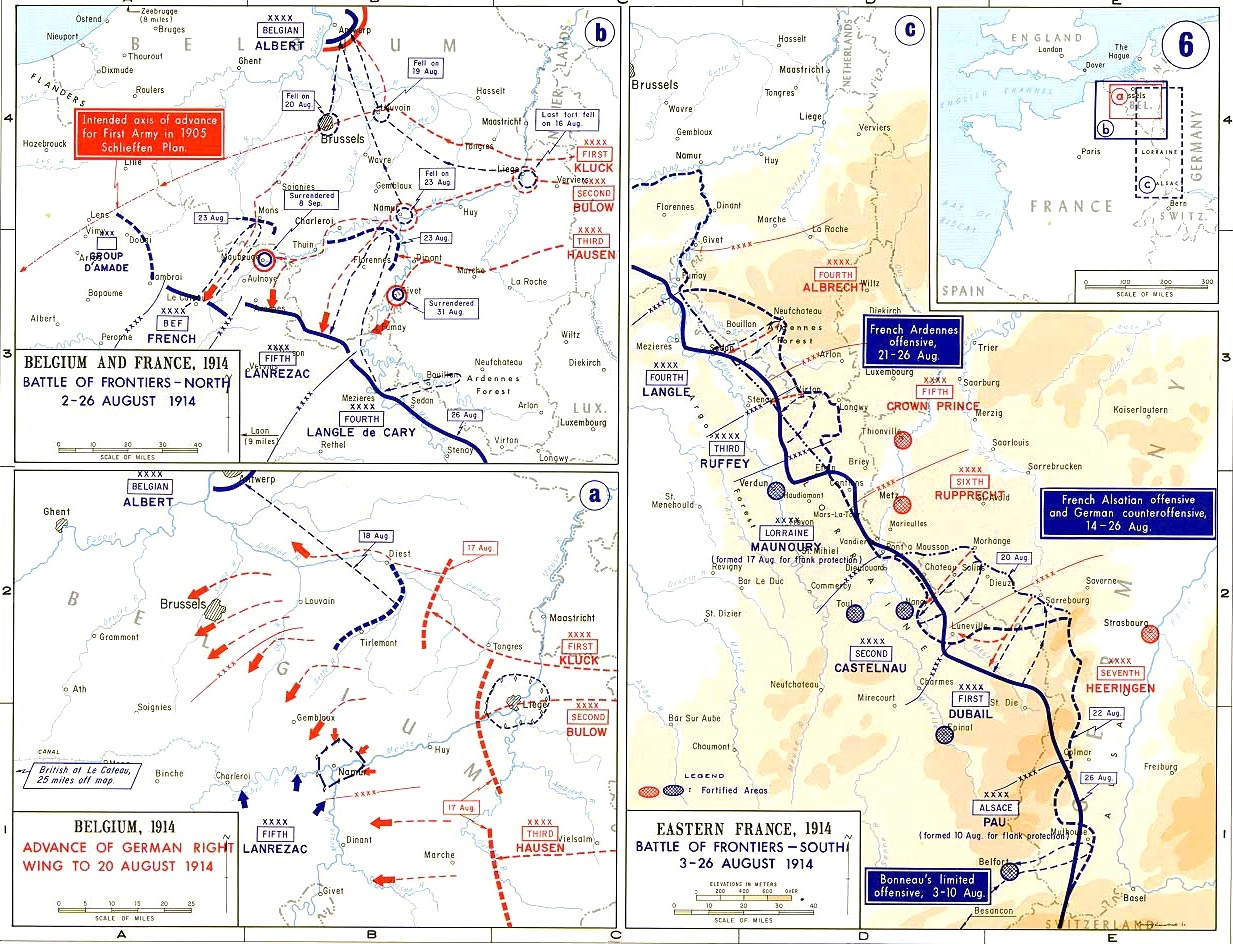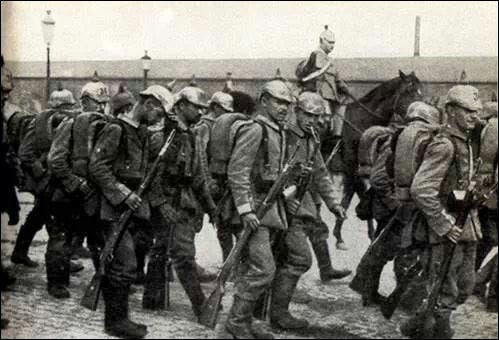Part Four: Opening Round in the West (1)
Note on Comparative General Officer Ranks
Rank structures and titles in the various armies of the Great War were not exactly equivalent. In the French Army there were only two permanent general officer ranks: General of Brigade (Général de Brigade) and General of Division (Général de Division). A General of Army Corps (Général de Corps d'Armee) or a General of Army (Général d'Armee) was actually a General of Division appointed to that higher command: He wore the insignia and used the title of his appointment during his tenure in command only. The title of Marshal of France (Meréchal de France) was technically not a rank but an honorific, conferred for distinguished service.
In the German Army all general officer ranks were permanent. These were Colonel-General (Generaloberst), General of Arm or Branch (General der Waffengattung), Lieutenant-General (Generalleutnant) and Major-General (Generalmajor). A General of Arm or Branch used the name of his parent branch of service, e.g. General of Infantry (General der Infanterie). The highest Army rank was Field Marshal (Generalfeldmarschall); in 1914 no general officer on the active list held this rank, which by custom was only conferred for distinguished service, usually in wartime. Kaiser Wilhelm II held it ex officio as monarch and "Supreme Warlord."
In the British Army also general officer ranks were permanent. These were Field Marshal, General, Lieutenant-General, Major-General and Brigadier-General. The Belgian Army had two general officer ranks: Lieutenant-General (Lieutenant-général) and Major-General (Major-général)
(For clarity, German unit designations are rendered in italics.)
The complexity and time sensitivity of the mobilization and deployment plans of Germany, France, Russia, and Austria-Hungary acted as an accelerant during the July Crisis that plunged Europe into war. Though men realized that mobilization meant war, they also knew that to delay mobilization in hopes of finding a diplomatic solution risked disaster. Days, even hours, mattered. For example, if France proclaimed mobilization, Germany must do likewise. So argued the generals on all sides, and the pressure this placed on governments proved irresistible. Thus when Russia ordered general mobilization on 30 July, the dominoes tumbled.
In the west, the first campaign of the Great War was shaped by the interaction of Germany’s amended Schlieffen Plan and France’s Plan XVII.
In sharp contrast to Schlieffen’s grand outflanking maneuver, Plan XVII was a straightforward proposition: an all-out frontal offensive. Its objectives were, first, to liberate Alsace and Lorraine, then to overrun the German Rhineland, and finally to carry the French armies to the Rhine River line. For this purpose, France’s five field armies were to be concentrated between the Belgian and Swiss borders. On the left, Fifth Army was to act as a flank guard in case the Germans attempted an attack through Luxembourg and southern Belgium. If that happened, the Fourth and Third Armies would advance northeast, into the Ardennes, there to meet and repulse the German attack. Otherwise they would advance east. Second and First Armies were to advance northeast into Lorraine. To the south of this main effort, a detached corps would advance into Alsace.
The map above shows the deployment areas of the French and German armies on 2 August. Note how the concentration of forces on the German right flank overlaps the French left.
Though the French commander-in-chief, General Joseph Joffre, recognized the possibility of a German flank attack through southern Belgium he never seriously considered the idea of a large-scale maneuver on the pattern of the Schlieffen Plan. Joffre reasoned that the Germans possessed insufficient first-line divisions for such an audacious operation. Discounting the value of his own reserve divisions, he failed to foresee that the Germans would use theirs in an offensive role. He judged, therefore, that his Fifth Army, supplemented by the British Expeditionary Force (Field Marshal Sir John French), would be adequate to secure the French left flank. Joffre paid no attention to the warnings of Fifth Army’s commander, General Charles Lanrezac, that the Germans were deploying in great strength along the Belgian border. Lanrezac was uncomfortably aware that until the BEF appeared on the scene, there would be nothing to the left of his army besides a thin screen of second-line Territorial troops along the Franco-Belgian border.
The Commander-in-Chief’s strategic misjudgment was compounded by some serious tactical deficiencies. In the years prior to the war the French Army had fallen under the sway of a faction that preached the doctrine of the offensive in its most extreme form. All professional soldiers in Europe shared this view, but in France it was embraced with an almost religious fervor. Relying on the bayonet and an aggressive spirit supposedly native to the French soldier, the troops would attack in dense formations, supported by the rapid fire of the excellent French 75mm field gun, closing with and overrunning the enemy in one irresistible rush.
There were, indeed, doubters and critics. Some argued that insufficient attention was being paid to infantry tactics and to the problems of coordination between infantry and artillery. Others pointed to the French Army’s material deficiencies, especially in medium and heavy field artillery. These criticisms the prophets of the offensive waved away with assurances that French cran—guts—would compensate for any such minor shortcomings. To suggestions that the traditional infantry uniform—dark blue coat, madder red trousers—should be replaced by something less conspicuous, they replied scornfully: Les pantalons rouges, c'est la France!
Given this background, what happened when Joffre launched his offensive was sadly inevitable. Between 14 and 23 August the French First Army (General Augustin Dubail) and Second Army (General Édouard de Castelnau) were bloodily repulsed at all points in Lorraine. Attacking in close order, bayonets fixed, regimental colors and saber-waving officers in front—sometimes even with regimental bands playing—the French infantry were mowed down in droves by rifle, machine gun and artillery fire. Against Sixth Army (Colonel-General Crown Prince Rupprecht of Bavaria) and Seventh Army (Colonel-General Josias von Heeringen), whose troops occupied well-sited defensive positions, the 75mm field gun proved ineffective. Only in Alsace, where the defending Germans were weakest, did the French enjoy a measure of success—but the ground gained there had mostly to be yielded back after the disaster farther north.
Worse was to follow. Preoccupied as he was with the fortunes of his offensive, Joffre was slow to recognize the danger looming on his left flank. The information that did come to hand convinced him that the Germans were attempting nothing more venturesome than the anticipated flank attack through southern Belgium. He therefore ordered Fifth Army to sidestep to its left, establishing touch with the BEF, now in the field with four infantry divisions, a cavalry division, and an independent cavalry brigade. (The BEF was supposed to have been six infantry divisions strong, but an invasion scare led the British government to hold back two divisions and some cavalry.)
Joffre also ordered Third Army (General Pierre Ruffey) and Fourth Army (General Fernand de Langle de Cary) to advance northeast into the Ardennes, there to meet and repulse the German advance. The French attack in this sector began on 21 August. But once more the French attacks, delivered in close order against well-posted defenders, broke down amid heavy casualties.
The second map above shows the French offensives in Lorraine and the Ardennes.
While these disasters were unfolding, the German right wing—consisting of First, Second and Third Armies—was advancing through Belgium. A special task force including super-heavy artillery reduced the Belgian fortified position at Liege, which covered the gap between the southern Netherlands and the Ardennes—an operation in which a certain Major-General Eric Ludendorff played a notable role. This cleared the way for First and Second Armies, which by virtue of some brilliant staff work were quickly passed through that narrow gap into Belgium.
First Army (Colonel-General Alexander von Kluck) initially moved northwest, engaging the Belgian Army (six infantry divisions and a cavalry division) on 17 August. After a hard-fought action, the Belgian commander, King Albert, ordered a withdrawal into the fortified position around the port of Antwerp. Thereupon First Army wheeled left toward Brussels; the Belgian capital fell on 20 August. Meanwhile Second Army (Colonel-General Karl von Bülow) and Third Army (Colonel-General Max von Hausen) advanced into the gap now open between the Belgians and the French Fifth Army. Fifth Army, stretching its left flank northward, found itself badly outnumbered and was driven back by Second and Third Armies. This heavy pressure on the French left also forced Fourth Army to give ground.
The advance of First Army brought it into contact with the BEF, deployed in defensive positions around the town of Mons. After some preliminary cavalry skirmishes, the Germans attacked in strength on 23 August, mainly in the sector held by the BEF's II Corps (General Sir Horace Smith-Dorrian). The rapid, well-directed rifle fire of the British infantry inflicted heavy casualties on the Germans before weight of numbers compelled the BEF to fall back.
The second map above shows the advance of the German right wing through Belgium and into northwestern France up to 26 August. Note how the line of advance of First Army began to diverge from that laid down for it in Schlieffen's scheme of maneuver. His attention fixed on the immediate tactical situation, Kluck deviated from the plan in an attempt to outflank the BEF and Fifth Army.
The Battle of Mons was the epilogue to a grievous and costly Anglo-French defeat. With the repulse in the Ardennes and the advance of the German right wing, the Battle of the Frontiers was over, and the Great Retreat was underway.
But at the headquarters of OHL (Oberste Heeresleitung or Army High Command) in Koblenz, General von Moltke was growing uneasy. His armies had done well thus far but where were the spoils of decisive victory: prisoners, captured guns and impedimenta? What was happening at the front? Moltke could not be sure. For as the field armies advanced, communications between them and OHL became fitful and uncertain. Radio, still in its infancy, was unreliable. Telegraphic and telephonic links were mostly unavailable. Dispatches from the armies carried by couriers took time to reach headquarters. And from the east, where a mere fraction of the German Army stood in defense of East Prussia, there came grim tidings of a massive Russian offensive.
As the terrible uncertainties accumulated, the Chief of the Great General Staff experienced the first twinges of the deadly fear that would finally paralyze his powers of decision, leaving a broken man at the head of the German Army.







In fairness to the French policy of attack, it had worked during the Napoleonic era when attacking French columns shattered the Russian and Austrian armies.
But 100 years had passed with the lessons of the American Civil War and the Russo-Japanese War teaching about firepower.